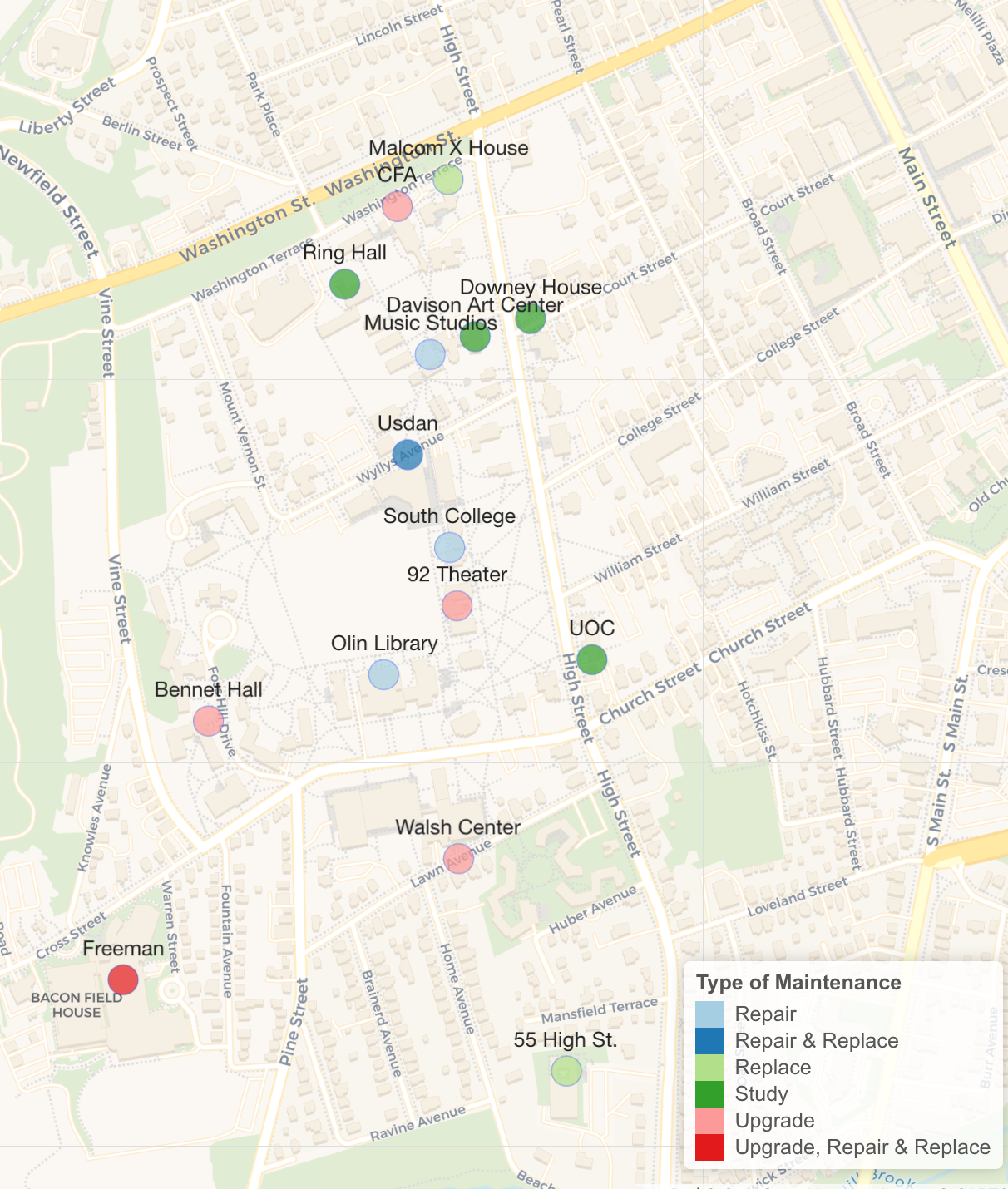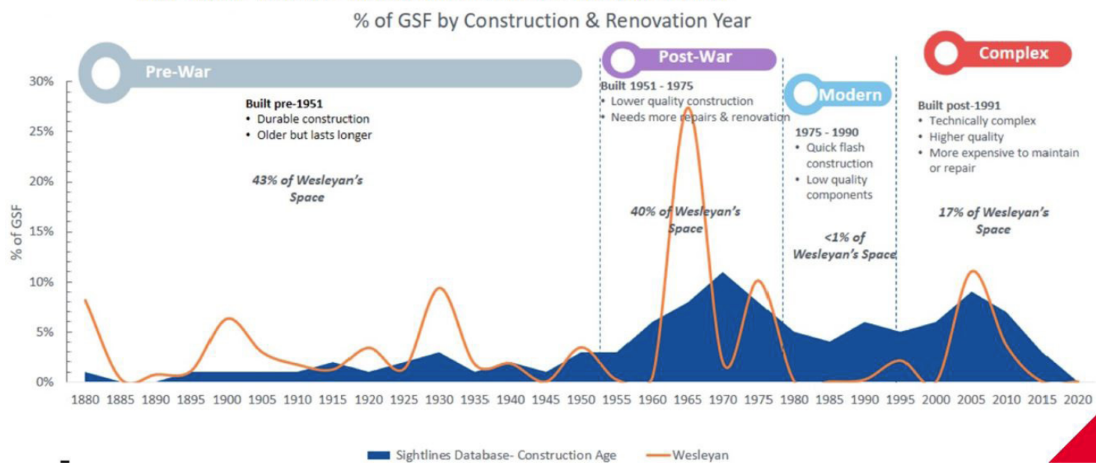Major Maintenance Committee reviewed potential maintenance projects and allocated the $3.8 million priorities budget for 2024 on Wednesday, Jan. 3. This annual budget is designated for costly and complicated projects that fall outside the scope of renovation, construction, and work orders. The Major Maintenance Committee funded 23 out of 28 proposals for the calendar year, including work on academic, residential, and student life spaces.
“Every single thing on the list [of proposed maintenance projects] is all important. It needs to happen,” Wesleyan Student Assembly (WSA) Student Life Committee Chair Ruby Clarke ’24, who is a member of the Major Maintenance Committee, said. “It’s just a matter of priority and where we’re going to be allocating our funding for the next year, and then certain things are differently urgent.”
The projects that the Major Maintenance Committee is prioritizing for 2024 consist of six studies to plan future work, six upgrades, six repairs, and five replacements. While some maintenance projects address disrepair and deterioration in spaces, others focus on updating older buildings for new purposes, understanding building conditions for future projects, or replacing parts to limit later costs. University Facilities Operations and Construction Services will work alongside outside contractors to accomplish these goals.
“A perfect example [of limiting maintenance costs] is kitchen counters in our wood frame houses,” Director of Construction Joseph Banks said. “If we get super-cheap formica, it’s going to get damaged very quickly, and we’ll have to replace it. So we’re trying to use more durable materials in that way. It’s just good sense and good design.”

c/o Caleb Henning
The University plans to study the University Organizing Center (UOC), moisture mitigation in Downey House, campus lighting, the Davison Art Center envelope, the Ring Family Performing Arts Hall, and wood frames.
The upgrades in question will be seen in Bennet Hall, the Freeman Athletic Center (FAC) bridge and training room, the structure of the Patricelli ’92 Theater, performance space in the Center for the Arts (CFA), and the Walsh Center for Retired Faculty.
Spaces receiving repairs include the entry of South College, parking lots, the roof and ceiling of Usdan University Center, the Music Studios elevator, the exterior of Malcolm X House, and the FAC courtyard stucco.
Finally, the University will be replacing the front door of Olin Memorial Library, the carpet in Usdan Marketplace, the air handler in FAC, a part in the sewage system beneath Usdan University Center, and the cooling tower at 55 High St.
“I’m kind of a building nerd, so all of them are interesting to me,” Banks said.
Facilities and Construction curates a list of candidate projects for major maintenance throughout the year, drawing on complaints and suggestions from students, academic departments, staff, and others. At the beginning of each year, the Major Maintenance Committee meets to discuss each proposal and vote on which projects should be prioritized.
“You can imagine Major Maintenance and Facilities as kind of this giant spider web that’s set up,” Banks said. “Basically, people call us. We get all kinds of stuff—complaints, suggestions, etc.—as to things that people are hoping to change.”
Banks noted that adding a project to the priorities list can be serendipitous.
“It’s really important in that process to look further out than just the immediate problem that’s presenting itself,” Banks said. “But then, when you begin looking at it more broadly—looking at all the systems that are going into the building, looking at how it’s used, looking at the conditions—oftentimes you can solve that original problem while also achieving a number of other objectives at the same time if you’re careful.”
Each member of the Major Maintenance Committee this year received 12 votes, physically represented by stickers, and could allocate up to three votes for each project. Afterwards, projects were funded based on budget and priority: Proposals were listed in order from most to least votes alongside their estimated costs and funded until the budget of $3.8 million was approximately reached. In their decisions, the 33 members of the Major Maintenance Committee prioritized preventing damage, maintaining accessibility, limiting future maintenance costs, updating spaces, and supporting pedagogy.

c/o Sightlines
“Some of those goals are making sure that we’re protecting the people that are involved,” Banks said.
The Major Maintenance Committee funded over 80% of proposals this year, with five projects falling outside the limits of the budget: Van Vleck Observatory dome repairs, Zilkha Gallery repairs, Olin window replacements, Fauver upgrades, and FAC field house duct and ceiling painting. Facilities plans to work on these projects as much as possible without outside contractors; break the projects into smaller, more manageable components; and renominate some projects for the maintenance priorities budget next year.
“Some of the things that weren’t approved were very expensive, high-ticket items,” Clarke said. “Part of the conversation that we had as a group was that some of the bigger stuff might be broken down into smaller things.”
Although large projects such as the construction of the new science building or the renovation of the Frank Center for Public Affairs are conspicuous on campus, maintenance is an integral part of the work done by Facilities. According to Banks, most buildings have a life cycle of approximately 20 years before they require maintenance and replacement. Less than 17% of spaces on campus, measured by total square footage, were built within the last 20 years; over 80% were built before 1975, and some are over two hundred years old. This is due in part to a period of intensive yet lower-quality construction after World War II, with 40% of spaces on campus built between 1951 and 1975.
“[Maintenance signifies] not necessarily a failure of the buildings, but rather sort of predictable life cycle costs,” Banks said.
Some of the priority projects target high-traffic buildings on campus. According to the Major Maintenance Committee meeting presentation, sewage from both Usdan University Center and Boger Hall accumulates in a pit in the basement of Usdan, resulting in frequent complaints about the smell. One of the projects funded for this year, which received the third-most votes, will address the issue by replacing the sewage pit with a sealed ejector system. Another project will replace the front door of Olin, which has been visibly pulled out of alignment with the door jamb by heavy use and now has problems locking.
“There was some stuff [like the door of Olin] where I was like, ‘Oh my gosh, I didn’t realize that was a problem,’” Clarke said. “There were a lot of things [like the sewage under Usdan] that I just thought I was making up.”
Clarke noted that students had especially expressed support for two projects on the priorities list: the ’92 Theater structural study and upgrading the Music Studios elevator, which dates to the mid-1970s. Although the University conducted a study on the ’92 Theater last year, the building cannot be upgraded or fully used until Facilities understands the structures that support the ceiling. Facilities completed the elevator repairs approximately two weeks ago.
“I know a lot of music majors are like, ‘Why is there no [working] elevator to the classrooms or to the studios? This is a necessary thing,’” Clarke said. “I think that that sentiment was really shared…. I’m really glad that that is getting done, because I know that’ll really impact people.”
The proposals included feedback from departments, organizations, and individuals across campus. The WSA Community Committee helped organize the proposal for a study on the UOC, which faces safety, accessibility, and water infiltration issues. Clarke emphasized the importance of continuing to involve students in the study once it begins.
“If students’ wishes aren’t respected, then the space isn’t functioning as it’s intended to be,” Clarke said. “I think it’s really important that as the University decides what to do for this building—and for the program and for its programmatic use—that we ensure that students are still involved with it or else the whole thing starts to fall apart.”
Banks highlighted the Ring Hall study as an example of a project that he finds interesting. Ring Hall was originally constructed in 1976 as a cinema, but it has been increasingly used for lectures and small concerts. As the function of the space has changed, issues have come up. The doors at the entrance are rusting, the HVAC system is outdated, the seats need repair, and the space is inaccessible because the auditorium relies on stairs. The priorities budget will provide the funds for an architect to study the space and create drawings, building on another study conducted on the CFA last year. The previous study focused on acoustics, audio-visual equipment, lighting efficacy and safety, and theatrical aspects such as rigging and aisle widths.
“Ring Hall was high on all of those things for not performing as well as it could, so that was one of the reasons that this was chosen this year,” Banks said.
Three projects on the final priorities list focus on residential spaces. Bennet, which received the second-most votes, will be unoccupied this summer for work converting steam pipes to hot water, providing the first opportunity since the building was completed in 2005 for major upgrades and repairs. The exterior of Malcolm X House will also be repaired, and a study of wood frames—which make up 22% of residential bed capacity on campus—will create floor plans, analyze conditions and elevations, and recommend certain houses for renovation. Clarke looks forward to seeing improvements to residential spaces through these projects and hopes that the wood frame study will result in improvements to accessibility.
“People spend a lot of time in dorm space, and I think that can really make or break a good college experience,” Clarke said. “I lived in Clark my freshman year…and I think that was a really great experience, and I want to help utilize that experience for everyone.”
Clarke pointed out that ultimately, the committee must balance practical and aesthetic concerns.
“Part of Major Maintenance is to make campus functional for people who are here, but there are also things that are perhaps less functional but are necessary for the image of Wesleyan,” Clarke said. “There is…this idea of Wesleyan that we’re trying to maintain.”
Elias Mansell can be reached at emansell@wesleyan.edu.
-
Glucorelief
-
is Gluco Relief fake